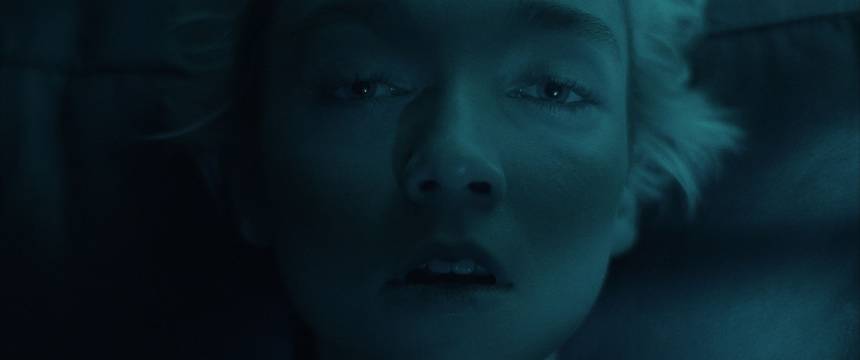Fantasia 2020 Review: COME TRUE, Nightmarish Terror Creeps Into Real Life

Sarah is finding it very difficult to get a good night’s sleep. She’s not staying at home, avoiding her mom as much as possible. Her friend will take her in whenever she can and some nights she’ll sleep in the park. But her sleep is always plagued by nightmares, dark visions, that always center on the Shadow Man. This goes far beyond a mild bout of insomnia. Sarah thinks she has found some respite when she joins a sleep study at a university. However relief is temporary and the nightmarish visions begin to creep into real life. Are her nightmare’s coming true?
The Shadow Man, the dark man with glowing eyes, should be a familiar entity to most of us in horror circles. We've recently seen it explored in depth in Rodney Ascher's documentary The Nightmare. Come True director Anthony Scott Burns wrote this film from his own personal experiences with sleep paralysis, nightmares, and visits from the Shadow Man. If anything from the nightmare sequences feels a bit personal to you it is because Burns knows. He knows.
The nightmare sequences are exceptionally creepy and unnerving. As they slowly move through doorways, hallways and open fields of chaos their targets are always the Shadow Man. Dream theory says that when you dream that you are crawling or going through a tunnel or hallway it is an indication that you are reliving a traumatic experience. So what traumatic experience has Sarah experienced?
There is a lot to unpack in just these sequences alone and they rank among the most unsettling moments of the film. So says I, stating the obvious, about ‘nightmare’ sequences. Well, they better be. Where it gets unnerving is where the dream world begins to seep into the real world.
Astute viewers will catch nods to Stanley Kubrick and by extent Rodney Ascher, George A. Romero and David Cronenberg. We’re pretty sure Cronenberg. You don’t grow up in Canada like Burns and some Anarchists have without hearing his name at least once a week, so you become familiar with his work. We can see Burns pastiche Cronenberg’s middle period of films where “location location location” was as much a character in the film as anyone in the cast.
Our appreciation for Burns as a filmmaker goes back many years, to his video and short film work. We have always respected his technical chops and gift for creating awesome visuals so we would expect nothing less from him. The nightmare sequences show the full breadth of his wizardry and he scales it back and works mostly with light and architecture to create his real world. Presumably the small production had to make use of the pre-existing light, both natural and artificial, casts an eerie glow on everything. Burns attempted to make his film look ‘unlit’ though he uses the ambient light given off by the retro futuristic tech too, even to the point of creating by way of shutters the vertical lines on an old screen.
We love the production design, It is top shelf for such a small production. Everything to do with the testing is retro futuristic, passing off digital era tech as new. We see your conversion of a top loader VCR into a dream recording machine and we tip our hat to thee, good sir! Accompanying the look is a synth-pop soundtrack provided by Canadian artists Electric Youth on top of what Burns has composed as himself and as his alter ego Pilotpriest. Should we interpret the combination of synth-pop and soft electric glow in the real world as a wink to the recent esthetic and influence of NWR?
Julia Sarah Stone is terrific as Sarah as she embodies her struggles, hopelessness and despair. She looks petite and frail but roars with anger and despair when called upon. Landon Liboiron’s Jeremy/Riff is our dubious villain if there is any in the film. His motives for helping Sarah are always in question. Is he helping her for her benefit, or for his own research?
There is some deeper meaning that Burns is striving for in his film and we are unsure if it is going to land with some. He holds the last shot for a reason and it is not just to give time for you to read the text but to really think about what the text is saying. We’ve watched the film a couple times now, once fresh and the second time armed with this new revelation from Burns himself and we must admit that it is a pretty well hidden, deeper meaning.
Also, think about Sarah’s phone. Think about her connection to it. Think back about who she is willing to take calls from and who she ignores. Think about how much she freaks out, how much any of us would, when she loses her phone midway through the film. That is another puzzle we have not quite cracked yet but once we cracked the mystery of that last shot of text then our train of thought dug a little deeper and we were ensured by Burns that we were on the right track.
We have not completely solved Burns’ puzzle and for those who want to dig deeper into his film there are layers to discover. At its most condensed Come True is a stylish and creepy sci-fi thriller, tipping its hat to some worthy predecessors. With a genuine creep factor it may keep you up at night and will definitely get under your skin.
Or, is it under your sheets?

Do you feel this content is inappropriate or infringes upon your rights? Click here to report it, or see our DMCA policy.






